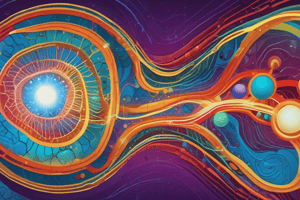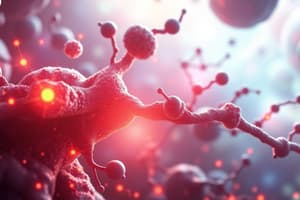Podcast
Questions and Answers
What is the immediate energy source that drives ATP synthesis by ATP synthase during oxidative phosphorylation?
What is the immediate energy source that drives ATP synthesis by ATP synthase during oxidative phosphorylation?
H+ concentration across the membrane holding ATP synthase.
Which metabolic pathway is common to both fermentation and cellular respiration of a glucose molecule?
Which metabolic pathway is common to both fermentation and cellular respiration of a glucose molecule?
glycolysis
What is the oxidizing agent in the reaction: Pyruvate + NADH + H+ → Lactate + NAD+?
What is the oxidizing agent in the reaction: Pyruvate + NADH + H+ → Lactate + NAD+?
pyruvate
When electrons flow along the electron transport chains of mitochondria, the pH of the matrix decreases.
When electrons flow along the electron transport chains of mitochondria, the pH of the matrix decreases.
During which metabolic process is most CO2 released from catabolism?
During which metabolic process is most CO2 released from catabolism?
Select the correct statement about cellular respiration.
Select the correct statement about cellular respiration.
How will a healthy individual's ATP production change during an eight-hour fast?
How will a healthy individual's ATP production change during an eight-hour fast?
What does glycolysis begin the process of?
What does glycolysis begin the process of?
What is the advantage of having an electron transport chain?
What is the advantage of having an electron transport chain?
Identify all correct statements about the basic function of fermentation. (Select all that apply)
Identify all correct statements about the basic function of fermentation. (Select all that apply)
Which of the following cheeses would likely spoil the most quickly?
Which of the following cheeses would likely spoil the most quickly?
A high fat cheese is denser than a low fat cheese.
A high fat cheese is denser than a low fat cheese.
What is required to connect a large quantity of lactose to acid in cheese making?
What is required to connect a large quantity of lactose to acid in cheese making?
Successfully making cheese requires separating _____.
Successfully making cheese requires separating _____.
When glucose is completely oxidized to carbon dioxide and water, where is most of the energy stored?
When glucose is completely oxidized to carbon dioxide and water, where is most of the energy stored?
Which two molecules are produced during glycolysis?
Which two molecules are produced during glycolysis?
What starts the process of glucose oxidation in glycolysis?
What starts the process of glucose oxidation in glycolysis?
What happens to the two carbons from the acetyl group of acetyl CoA in the citric acid cycle?
What happens to the two carbons from the acetyl group of acetyl CoA in the citric acid cycle?
Which compounds are the net inputs and outputs of oxidative phosphorylation?
Which compounds are the net inputs and outputs of oxidative phosphorylation?
Match each stage of cellular respiration with the cellular location in which it occurs:
Match each stage of cellular respiration with the cellular location in which it occurs:
What is the direct role of O2 in mitochondrial electron transport?
What is the direct role of O2 in mitochondrial electron transport?
How do anaerobic conditions affect electron transport and ATP production during oxidative phosphorylation?
How do anaerobic conditions affect electron transport and ATP production during oxidative phosphorylation?
Why is more ATP made per molecule of NADH than per molecule of FADH2?
Why is more ATP made per molecule of NADH than per molecule of FADH2?
What effect does gramicidin have on ATP synthesis?
What effect does gramicidin have on ATP synthesis?
Which compounds couple the stages of cellular respiration?
Which compounds couple the stages of cellular respiration?
What happens in the absence of oxygen during electron transport?
What happens in the absence of oxygen during electron transport?
What effect does increased ATP demand have on ATP production?
What effect does increased ATP demand have on ATP production?
What would happen to the cell's rate of glucose utilization with increased ATP demand?
What would happen to the cell's rate of glucose utilization with increased ATP demand?
Which molecule is metabolized to produce energy for performing work in the cell?
Which molecule is metabolized to produce energy for performing work in the cell?
The potential energy in an ATP molecule is derived mainly from its three phosphate groups.
The potential energy in an ATP molecule is derived mainly from its three phosphate groups.
Which process is not part of the cellular respiration pathway that produces large amounts of ATP?
Which process is not part of the cellular respiration pathway that produces large amounts of ATP?
Which step of the cellular respiration pathway can take place in the absence of oxygen?
Which step of the cellular respiration pathway can take place in the absence of oxygen?
Into which molecule are all the carbon atoms in glucose ultimately incorporated during cellular respiration?
Into which molecule are all the carbon atoms in glucose ultimately incorporated during cellular respiration?
Which of the following statements about the electron transport chain is true?
Which of the following statements about the electron transport chain is true?
Which stage of glucose metabolism produces the most ATP?
Which stage of glucose metabolism produces the most ATP?
The reactions that generate the largest amounts of ATP during cellular respiration take place in the mitochondria.
The reactions that generate the largest amounts of ATP during cellular respiration take place in the mitochondria.
The electrons stripped from glucose in cellular respiration end up in which compound?
The electrons stripped from glucose in cellular respiration end up in which compound?
Which statement about the chemiosmotic synthesis of ATP is correct?
Which statement about the chemiosmotic synthesis of ATP is correct?
Study Notes
ATP Synthesis and Oxidative Phosphorylation
- ATP synthesis during oxidative phosphorylation is driven by the H+ concentration gradient across the membrane.
- The final electron acceptor in the electron transport chain is oxygen.
Metabolic Pathways
- Glycolysis is the common pathway for both fermentation and cellular respiration of glucose.
- The citric acid cycle is responsible for most CO2 release from catabolism.
Cellular Respiration Concepts
- Cellular respiration occurs at the cellular level, while breathing is an organism-level process.
- A healthy individual’s ATP production remains stable during an eight-hour fast.
- Glycolysis initiates glucose catabolism, converting glucose into two pyruvate molecules with a net gain of two ATP.
Enzyme Activity and Regulation
- Phosphofructokinase (PFK) is more active at low ATP concentrations and is an allosteric enzyme inhibited by ATP and stimulated by AMP.
- Substrate-level phosphorylation produces ATP in glycolysis and the citric acid cycle, accounting for all ATP formed in glycolysis.
Products and Outputs of Glycolysis and Citric Acid Cycle
- Glycolysis produces 2 NADH, 2 pyruvate, and a net of 2 ATP.
- In glycolysis: glucose is consumed, resulting in the production of ATP and NADH; does not involve O2 uptake or CO2 release.
- The citric acid cycle produces ATP, NADH, and FADH2 while releasing CO2.
Redox Reactions in Cellular Respiration
- The oxidation of glucose yields electrons stored in NADH and FADH2, retaining most energy from glucose.
- NAD+ is reduced to NADH during glycolysis, pyruvate oxidation, and the citric acid cycle.
- Electrons moving to more electronegative atoms indicates reduction and energy release.
Energy Production
- Most energy stored in NADH and FADH2 is used for ATP production during oxidative phosphorylation.
- Catabolic processes generate ATP when immediate ATP supply is exhausted.
Fermentation
- Fermentation regenerates NAD+ to maintain ATP production through glycolysis.
Importance of Carbon Compound Transformation
- For every glucose molecule, four CO2 are released during the citric acid cycle.
- Acetyl CoA formation includes the oxidation of pyruvate to produce NADH and release CO2.
Conditions Affecting Cellular Respiration
- Anaerobic conditions halt electron transport and ATP production, as oxygen is essential for functioning as the final electron acceptor in the chain.
Additional Key Points
- Electronegativity describes an element's ability to attract electrons.
- Ionic bonds form through complete electron transfer, exemplified by lithium fluoride.
- High-energy foods like carbohydrates and fats have numerous electrons associated with hydrogen.
Location of Cellular Respiration Processes
- Glycolysis occurs in the cytosol, while the citric acid cycle and oxidative phosphorylation processes occur in the mitochondrial matrix and inner mitochondrial membrane, respectively.
Cheese and Fermentation
- Low fat, low salt cheeses spoil quicker; cheeses with little water are generally higher in fat. Bacteria are crucial for lactose fermentation into acid.
- Successful cheese-making requires the separation of curds and whey.### Cellular Respiration Overview
- Electron transport and ATP synthesis cease if no electron donors are available.
- NADH results in more ATP production compared to FADH2 due to fewer protons being pumped across the mitochondrial membrane with FADH2.
Effects of Gramicidin
- Gramicidin increases proton permeability of membranes, disrupting the proton gradient essential for ATP synthesis.
- Despite this leakiness, the processes of proton pumping, electron transport, and oxygen uptake continue unaffected.
Coupling of Cellular Respiration Stages
- The four stages of cellular respiration are interconnected, with outputs from one stage serving as inputs for another.
- Key molecules involved in coupling include pyruvate, NADH, and NAD+.
Impact of Oxygen on Electron Transport
- Absence of oxygen halts electron transport, preventing NADH from converting back to NAD+, which is crucial for earlier stages of cellular respiration.
Regulation of Cellular Respiration
- Cellular respiration is regulated by ATP levels through feedback inhibition.
- High ATP concentrations inhibit phosphofructokinase (PFK), reducing the glycolytic rate; decreased ATP levels lift this inhibition, enhancing ATP production.
Glucose Utilization
- Increased ATP demand results in significantly heightened glucose utilization rates.
Primary Energy Source
- Glucose is the primary molecule metabolized within cells for energy production.
ATP Structure and Function
- ATP's potential energy chiefly arises from its three phosphate groups, affirming its crucial role in energy transfer.
Cellular Respiration Processes
- Fermentation is not part of the ATP-producing cellular respiration pathway.
- Glycolysis is the only cellular respiration step that can proceed without oxygen.
Carbon Dioxide Production
- All carbon atoms from glucose are converted into carbon dioxide during cellular respiration.
Electron Transport Chain
- Electrons from NADH and FADH2 are donated to the electron transport chain, driving ATP production.
Major ATP Production
- The electron transport chain and chemiosmosis are responsible for generating the highest amounts of ATP during glucose metabolism.
- The largest ATP-producing reactions occur within the mitochondria.
Final Electron Acceptors
- The electrons stripped from glucose during cellular respiration end up contributing to water formation in the end stages.
Chemiosmotic ATP Synthesis
- ATP is synthesized via chemiosmosis through the coupling of electron transport and proton movement across the inner mitochondrial membrane.
Studying That Suits You
Use AI to generate personalized quizzes and flashcards to suit your learning preferences.
Description
Test your knowledge of key concepts from Chapter 9 of Biology. This quiz covers important terms and definitions related to ATP synthesis, metabolic pathways, and oxidation-reduction reactions. Perfect for reinforcing your understanding of cellular respiration and fermentation.





